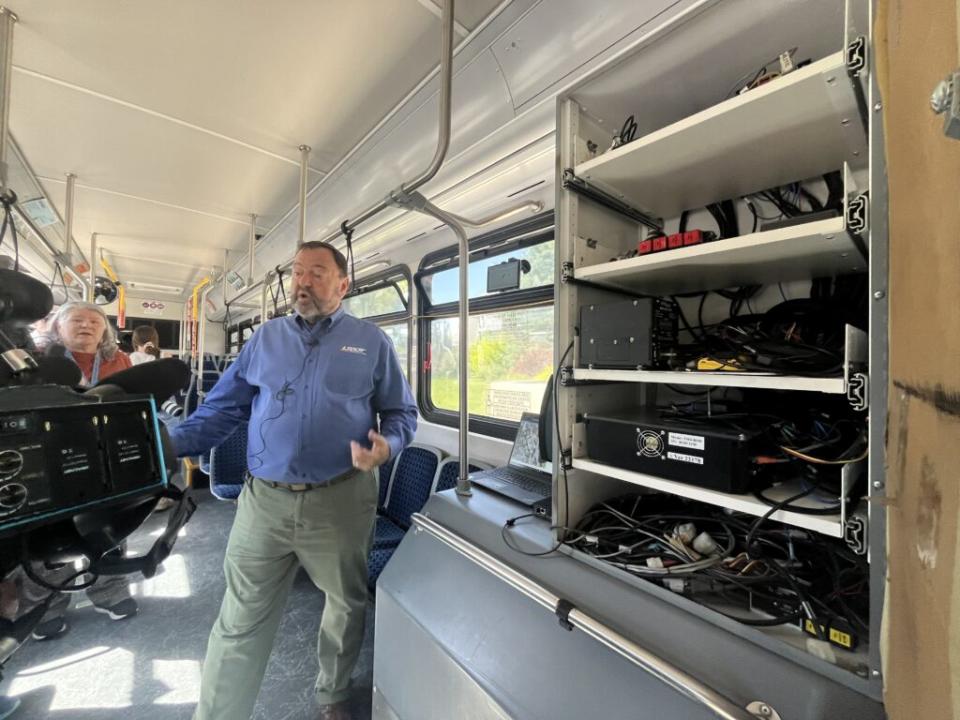Utah vehicles may be able to communicate with roads soon with V2X technology expansion

Blaine Leonard, transportation technology engineer at UDOT, explains how V2X technologies work at a Salt Lake City intersection, along with UDOT executive director Carlos Braceras and Federal Highway Administrator, Shailen Bhatt on June 20, 2024. (Alixel Cabrera/Utah News Dispatch)
What if cars, bikes and buses in Utah are able to receive messages from roads to avoid accidents? The state’s infrastructure could send signals predicting a driver may run a red light, lights could change to green when emergency vehicles need to reach a destination faster, or a bridge could tell a car to slow down to avoid an accident.
That’s a technology the Utah Department of Transportation has been working on for a couple of years. It’s on some Utah Transit Authority buses and snow plows and now is poised to expand with newly allocated federal funding. Out of a $60 million funding pool, Utah is set to receive $20 million from the Federal Highway Administration to partner with Wyoming and Colorado in the endeavor.
“This is kind of a big deal. This is going to create a change in our industry,” Carlos Braceras, executive director of UDOT, said in a news conference Thursday. “We’re at this point where technology is merging with transportation like never before, and I think we’re seeing this big change happening right now.”
GET THE MORNING HEADLINES DELIVERED TO YOUR INBOX
The technology’s name is V2X, an acronym for “vehicle-to-everything,” a system that could connect roads, traffic lights and other infrastructure pieces to vehicles. In the future, officials said, the hope is that cars have installed systems that may send signals if, say, they’ve suddenly stopped and their airbag is activated at a curve, so that other vehicles don’t speed near the crash.
In a visit to Salt Lake City, Shailen Bhatt, federal highway administrator, said that while technology has transformed many things, there were over 40,000 traffic fatalities in the country in 2023 “because we have not been as courageous, or as quick to deploy technology in transportation.”
The system, for example, could have sent a message to all vehicles approaching the Baltimore Bridge — which collapsed in March after a container ship crashed into one of its piers — telling them to stop.
Bhatt announced that the federal government funding will be assigned to installing the technology in plows, buses and signals.

“We’ve had this long chicken or egg battle around this issue. Put it into vehicles but there’s no infrastructure, or should we put the infrastructure out there even though there’s no vehicles (with V2X),” Bhatt said. “With this announcement today. We’re hoping to further that environment so that automotive manufacturers will see the need to deploy at scale, because that’s the only way that we’re truly going to get connectivity out there.”
The safety improvements could compare to the introduction of ubiquitous technologies like airbags and mandatory seat belts, Braceras predicted.
That safety factor is what Salt Lake City Mayor Erin Mendehall said she’s the most grateful for.
Let us know what you think...
“It’s a way of thinking about using technology that we hadn’t even contemplated, I think, just a matter of two years ago. This is a wonderful thing. It’s a huge advantage for the state of Utah and just a couple of other states to be at the forefront of this investment with our federal partners,” Mendenhall said on Thursday.
Utah Transit Authority buses have been implementing the technology in recent years. The buses have developed far beyond past versions, Jay Fox, executive director of the authority said in the news conference. There are 11 electric buses with V2X technology in Ogden. The plan is to install the system in UTA’s entire fleet in five years.
“(With) our buses, our entire system, we moved 80 million customers last year. That’s an increase of 15% over the previous year,” Fox said. “The demand for our service is growing and our customers need to trust that the bus will be there when it’s supposed to be there.”
Combining V2X with Transit Signal Priority — a communication technology which allows traffic signals to give extra green light time to help buses that are behind schedule to catch up — would help to keep buses on time, he added.
The post Utah vehicles may be able to communicate with roads soon with V2X technology expansion appeared first on Utah News Dispatch.

